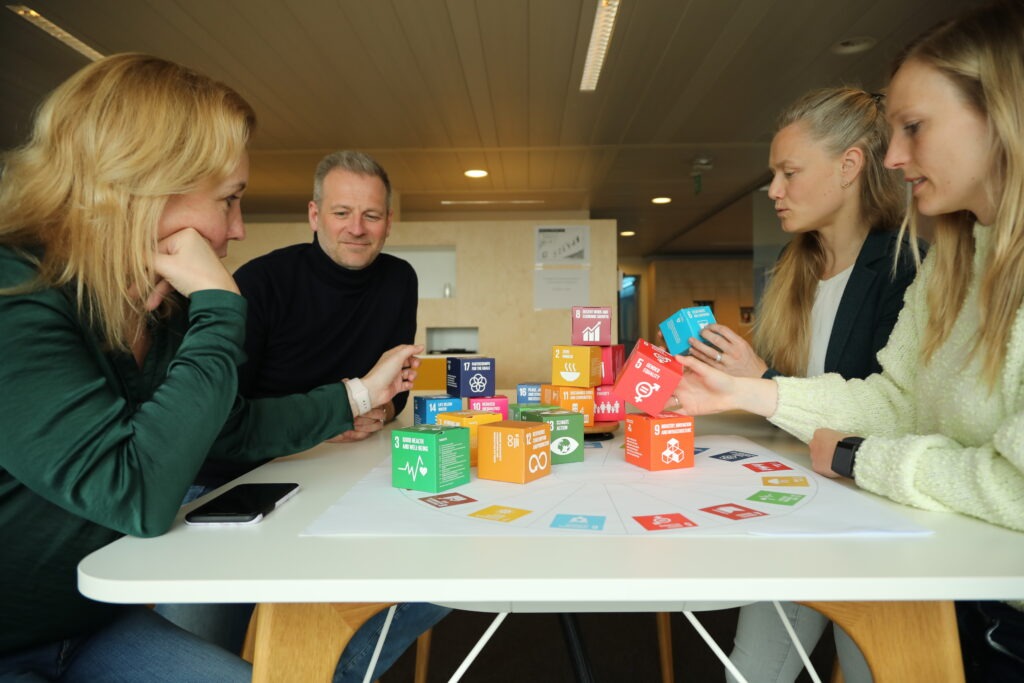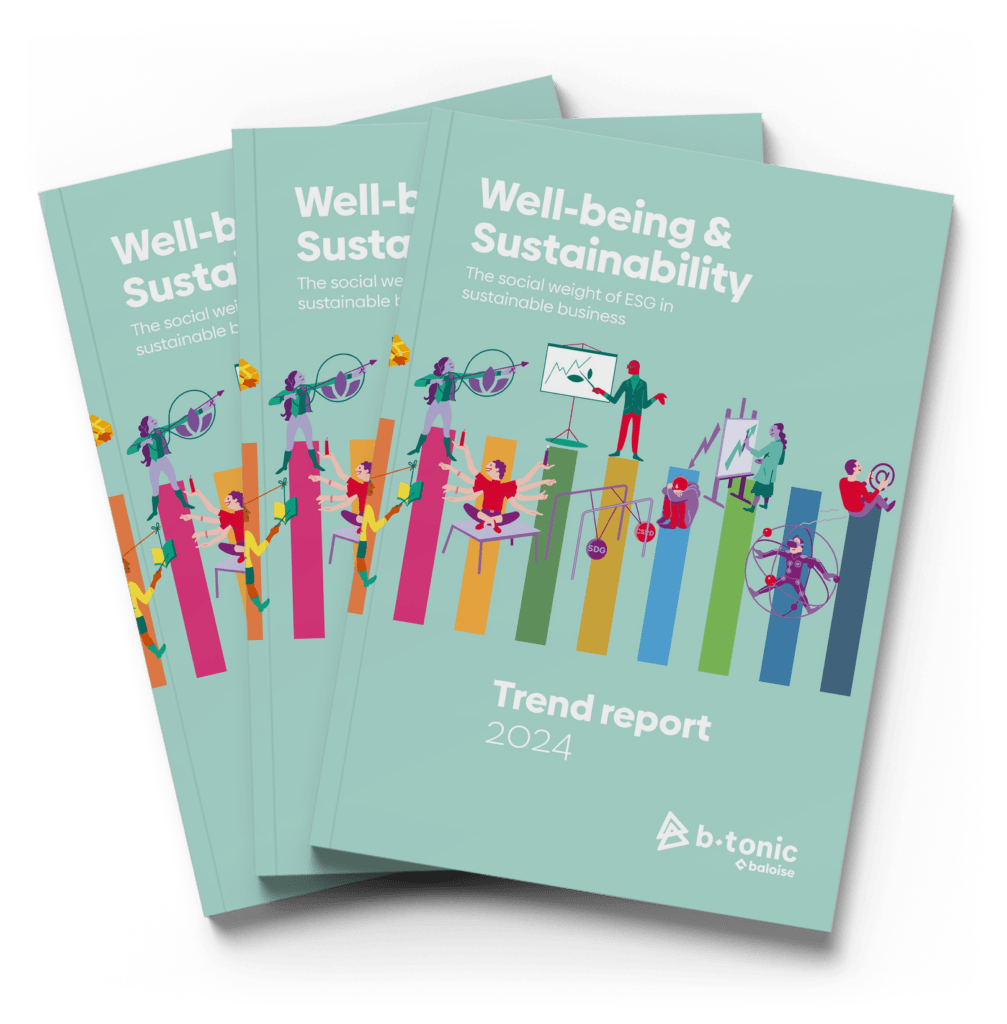Exciting work starts with recruitment. That is the surprising conclusion of participants at the round-table discussion, organised by HR magazine. Yet, that is only the beginning. A lot of other conditions – such as good leadership – are needed to create well-being in teams.
For Siviglia Berto (B-Tonic), engaging work means going home with at least as much positive energy as you started your working day with. Work should not absorb energy. “That is the most important aspect of engaging work that I apply to myself and my team.
Despite difficult, busy periods and stress, the energy level at the end of the working day should be at least the same as at the beginning of it. If you can complement that with what your family and hobbies bring, then your well-being is being respected and you can go through life happily.”
Bart Mariman (ISS Facility Services) has similar thoughts: “Number one in the job description is the energy balance. Tasks that cost you energy, you do not like doing and you may not do these tasks well. They will drown you. I do realise that the definition of engaging work will be different for everyone. Tasks from which you get energy are most important to me too, even though that may mean someone likes doing the same thing all day. You cannot just define that for everyone.”
Autonomy
Hilde Janssens (Koramic2Engage) starts with autonomy for her definition. “That does not mean that you decide on everything yourself, but it does mean that you perform tasks that you consider relevant. Competence is the second aspect. You have to feel that you are up to the challenges. Connectedness is the third element that I find important in exciting work. You have to feel that you are adding value. That brings me to the values fit. A good match between the job you have to do and the values you have creates more connection. Engaging work is not a one-size-fits-all, but tailor-made.”
Bram Dierckx (Plantyn) sees an evolution in corona times. “What happened recently is important for job happiness and for what makes work engaging. There is the focus on the personal on the one hand and on the other hand, non-work related issues have become more important in the workplace. The separation between personal and work has become less. We have to adapt to this as an employer. We now organise more events that are not work-related, but focus on connection. Things that used to happen outside work now take place at work and contribute to being engaging.”
The environment is sometimes as important as the job content to keep a job engaging’
Bart Mariman
Tasks
As a result, tasks have to be handled differently than before, Bart Mariman points out. He sees that teleworking has led to a move away from traditional tasks. “You have to work with management by objectives. This means explaining what you expect, without translating it into tasks. If something does not work out, come to me, but otherwise do autonomously what is asked of you. Obviously this does not apply to all jobs, but we must give employees freedom where they can. That is what makes work exciting.”
Bram Dierckx agrees with this. He suggests demarcation. “We tried to do that by letting go of job descriptions and switched to roles, delineating responsibilities. In doing so, we leave enough autonomy and freedom. You may turn to a colleague for tasks you are less able or willing to do, but it is still your responsibility that it happens.” Hilde Janssens sees digitalisation playing a role in the evolution of the modern task. “For boring, repetitive and therefore numbing tasks, you can usually turn to technological tools. That leaves mostly engaging tasks. But engaging work is more than just engaging tasks. It is a framework within which someone feels comfortable. Not everyone wants to be autonomous or self-managing and self-developing. That is why I come back to my values fit.”
Retention is the new recruiting. Competencies also remain important, but they can be developed’
Hilde Janssens
LOOK
Bram Dierckx endorses the importance of recruitment to later achieve engaging work and well-being. He is still looking for how he can put even more effort into this approach. “Candidates often come to us because of our work-gear brand. They think the job content is important, but our look determines whether someone applies or not.” Siviglia Berto nuances that today it is up to the applicant. “It takes much more than a fruit basket or fitness to attract the right people.”
So is valuefit-based hiring the only means to engaging work and thus well-being? Not at all, Hilde Janssens says. Yet she maintains that this marks a very important – but not the only – step. “We swear by the quality of recruitment and back that up with data. Engagement and wellbeing result from proper recruitment. Yet that is only the beginning. Good leadership is a necessary next step. That should work on correct and valid tasks, efficiency and good organisation. Proper remuneration and an appropriate work-life balance are also part of that balance. It is a case of and-and.”
Production is higher anyway with employees who find their tasks engaging’
Siviglia Berto
LEADERSHIP
The evolution towards coaching leadership is key, experts around the table say. It should make people feel psychologically safe. HR also has its role in creating engaging work. Participants see the task as a partnership between HR and the other departments, with HR being the process facilitator. Siviglia Berto: “Today, well-being is a mission of the entire organisation. This is often underestimated. Yet for me, too, HR is the most important player when it comes to engaging work and well-being.”
Bram Dierckx indicates that HR initiates the vision and process, but it is the leaders who do primary HR: “HR sets the lines for engaging work. It is the leaders who make the difference.”
GOOD ENVIRONMENT
Bart Mariman knows from experience with clients, that candidates sometimes sign a contract because the environment suits them. “Whoever starts a new journey has to get into a decent infrastructure. You should not put employees in a windowless basement. That is caricatural, but I mean the environment is important to keep a job engaging, sometimes as important as the job content.”
Still other things are important to him. Recognition and appreciation top the list. “We used to ask our employees not to have eye contact when they entered an office somewhere. So how can you ask them to take pride in their work? Today, we recruit caretakers and talk about leadership with a personal touch: they are the CEO of the square metre around them. That makes them responsible for their customer’s happiness and satisfaction. It makes their work more engaging and gives them recognition and appreciation.”
Hilde Janssens: “That is about the energy balance of those employees. You get energy when customers and employers thank you.”
COLLEAGUES AND LEARNING
Bart Mariman adds that colleagues also have their stake. “Work satisfaction is enhanced when you have a good friend at work. Then you can lose a lot. Not infrequently it ensures that employees enjoy getting up and not working against their will. We find that a good colleague or even a good superior makes your work more engaging and increases job satisfaction.” Colleagues need to learn to appreciate each other, Siviglia Berto knows, and that certainly applies across generations. “The older generation is especially different from the younger ones in terms of digital, who are handy with apps and digital solutions. Generations can teach each other things.” Learning remains an important element for her in the quest for exciting work. “Everything evolves super fast. Not everyone likes that. Those who become accountants no longer work in the same way for 20 years. You have to keep work engaging by letting employees learn and evolve for life. It makes people feel good to be trained.”
ORGANISING
Bram Dierckx organises things outside work to increase well-being and make work more exciting: “That could be about the classic Saint Nicholas party, but a family day was also on our agenda when we moved. Only, those initiatives do not work for everyone. It is difficult to get all employees together, but those who come are happy with the initiatives. For instance, board games have been more successful than expected.”
Bart Mariman recognises the phenomenon: “It is often the same people who come, but that should not stop you from organising some things. Today we even had to do that to get employees back to the office after the pandemic.” It brings experts around the table in efforts to improve well-being at work. Siviglia Berto: “People often ask me what HR efforts on engaging work and well-being yield. But it is difficult to calculate the ROI of that. The impact of efforts to make me-workers feel better is difficult to convert into pennies, turnover and output. That said, I am sure the many HR efforts throughout the organisation have positive impacts. Production is always higher with employees who find their tasks engaging. I just often need data to prove that.”
‘ The separation between home and work has become less present. We have to adapt to that as employers’
Bram Dierckx
JOBCRAFTING
Hilde Janssens reviews the importance of jobcrafting. She considers the interest of her team members and sees what they like to do. In the contact centre world, they are experimenting with it. “To make work more workable, we need to move in that direction. In a team, one colleague is more sales-oriented, the other rather technical. You can model the work at team level and make it more interesting for everyone. People get more freedom and can partly organise their work themselves. That way, you create jobs that best suit your employees. You get out of the profile what employees themselves find important and interesting.”
Bart Mariman occasionally sees things turning out wrong. He sometimes sees employees with bore-out or burnout, but points out that this is often not just the result of job description. “Repetitive tasks can lead to bore-out. On the other hand, I find that burn-out is rarely the result of task content alone. Almost always it is private matters, for example a relationship on the rocks, that are partly to blame and undermine employees’ well-being at work.” Siviglia Berto agrees: “The private part has become an increasingly important part since covid-19. HR has to keep up with this evolution and facilitate when things threaten to go wrong. Employees who are having a hard time at home do not always dare to admit it. When burnout occurs, the manager has an impact, which is sometimes underestimated. The leader should always intervene, but in a positive way. Not as in the evaluation process, where the focus is usually the negative. After that, the reintegration process becomes very important. The employer has to take care of the to-back of his employees and accommodate them appropriately. We already have 470,000 long-term sick people in our country and the next wave is yet to come.”
Source: HR magazine January





